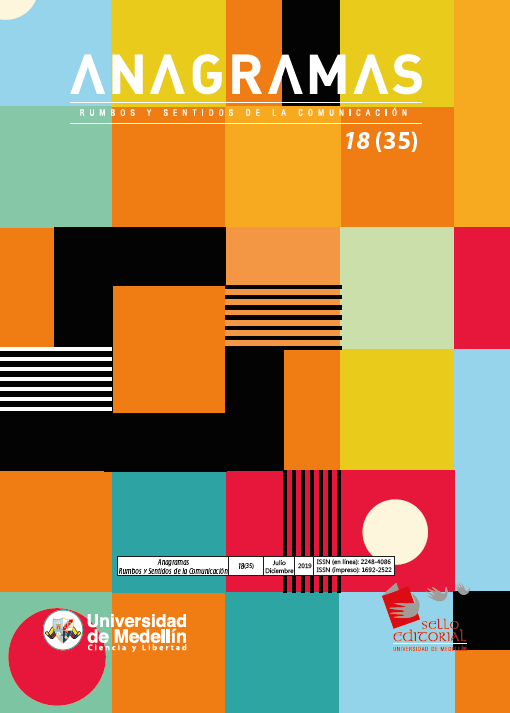Palavras-chave:
Copyright and Licensing:
Copyright (c) 2023 Anagramas Rumbos y Sentidos de la Comunicación

This work is licensed under a Creative Commons Attribution-NonCommercial-NoDerivatives 4.0 International License.
- Articles
- Enviado: maio 11, 2018
-
Publicado: setembro 9, 2019
Resumo
Este artigo faz referência à pesquisa sobre a função social da radio universitária no México, inscrito no contexto de pesquisas em meios de comunicação universitários. Retoma-se a proposta teórica de Manuel Martín Serrano e o modelo de comunicação massiva do professor Carlos Lozano. O objetivo geral da pesquisa esteve em analisar a mediação comunicativa associada à programação radiofônica de três estações de rádio universitárias (Radio UANL89.7, Frecuencia TEC 94.9 e Radio UDEM 90.5) a partir da perspectiva comunicativa da mensagem e do impacto de elementos que intervêm na construção de produtos radiofônicos, os quais são apresentados de forma imediata sob a classificação de formativos, informativos e de entretenimento. Para a indagação do tema, implementou-se uma metodologia quantitativa e escolheu-se “tempo de duração” como variável de impacto para medir o tempo de programação diária, assim como o cotejo das temáticas e dos produtos comunicativos projetados pelas rádios. Os resultados obtidos indicaram que a temática musical ocupa entre 60 % e 67 % da programação. A generalidade que os programas radiofônicos universitários expõem é uma homogeneidade no horário matutino, devido ao fato que os conteúdos informativos tomam conta da maioria dos espaços nas três emissoras e assim proporciona uma opção a mais no quadrante que beneficia à função social. As conclusões obtidas indicam uma aposta na diversificação da programação e uma prática comunicativa baseada em oferecer entretenimento culto e mostrar um espaço novo de inter-relação, bem como sua compreensão do desenvolvimento identitário da universidade.Referências
- Alcoceba, J. (1999). La producción comunicativa de la referencia: un análisis mediacional de las noticias del teletexto en España (tesis doctoral). Universidad Complutense de Madrid.
- Arias, M.A. (1982).Una aplicación del modelo dialéctico el proceso de mediación estructural en la prensa escrita. REIS: Revista Española de Investigaciones Sociológica, (33), 175-186.
- Camacho, L. (2004) Una historia hecha de sonidos, radio educación, la innovación del cuadrante. Colección Innovación y Calidad, Secretaría de Educación Pública.
- Escorcia, O. (2010). Manual para la investigación. Guía para la formulación, desarrollo y divulgación de proyectos. Universidad Nacional de Colombia.
- Giner, S. (1967). Historia del pensamiento social. Editorial Ariel.Glaser, B., y Strauss, A. (1967). The Discovery of Grounded Theory. Aldine Press.
- Gómez-Escalonilla, G. (1998). La programación televisiva en España. Estudio de las parrillas de programación televisiva española desde 1956 a 1996 (tesis doctoral). Universidad Complutense de Madrid.
- Hernández, R., Fernández, C., y Baptista, P. (2002).Metodología de la investigación. McGraw-Hill.
- Hinojosa, L. (2012). Educación, ciencia y cultura: Miradas introspectivas a las comunidades universitarias en México. Editorial Comunicación Social.
- Lozano, J. (2007). Teoría e investigación de la comunicación de masas. Pearson Educación.
- Martí, J. (2000). De la idea a l’antena. Tècniques de programació radiofónica. Editorial Pòrtic.
- Martín Serrano, M. (2009). La producción social de la comunicación. Editorial Alianza.
- Martín Serrano, M., Piñuel, J. Gracia, J., y Arias, M. (1982). Teoría de la Comunicación, 1.ª epistemología y análisis de referencia. Editorial Universidad Complutense de Madrid.
- Moreno, E. (2005). Las radios y sus modelos de programación radiofónica. Comunicación y Sociedad, 53(1), 80-105.
- Piñuel Raigada, J. (1990). Cultura y comunicación política en la transición en Chile. Editorial Cedeal.Ross, E. A. (1901). Social Control: A Survey of the Foundations of Order. Macmillan Co.
- Toussaint, F. (1991). La radiodifusión universitaria nacional: 50 años de persistencia. En M. Rebeil, Perfiles del cuadrante. Experiencias de la radio (pp. 81-82). Trillas.
- Ventín Pereira, J. (2003). Programación radiofónica: una propuesta teórica. Editorial Fragua.
Como Citar
Villanueva Valadez, C. (2019). A função mediadora da programação radiofônica universitária na cidade de Monterrey, Nuevo León. Anagramas Rumbos Y Sentidos De La Comunicación, 18(35), 159-175. https://doi.org/10.22395/angr.v18n35a9
Downloads
Não há dados estatísticos.





























